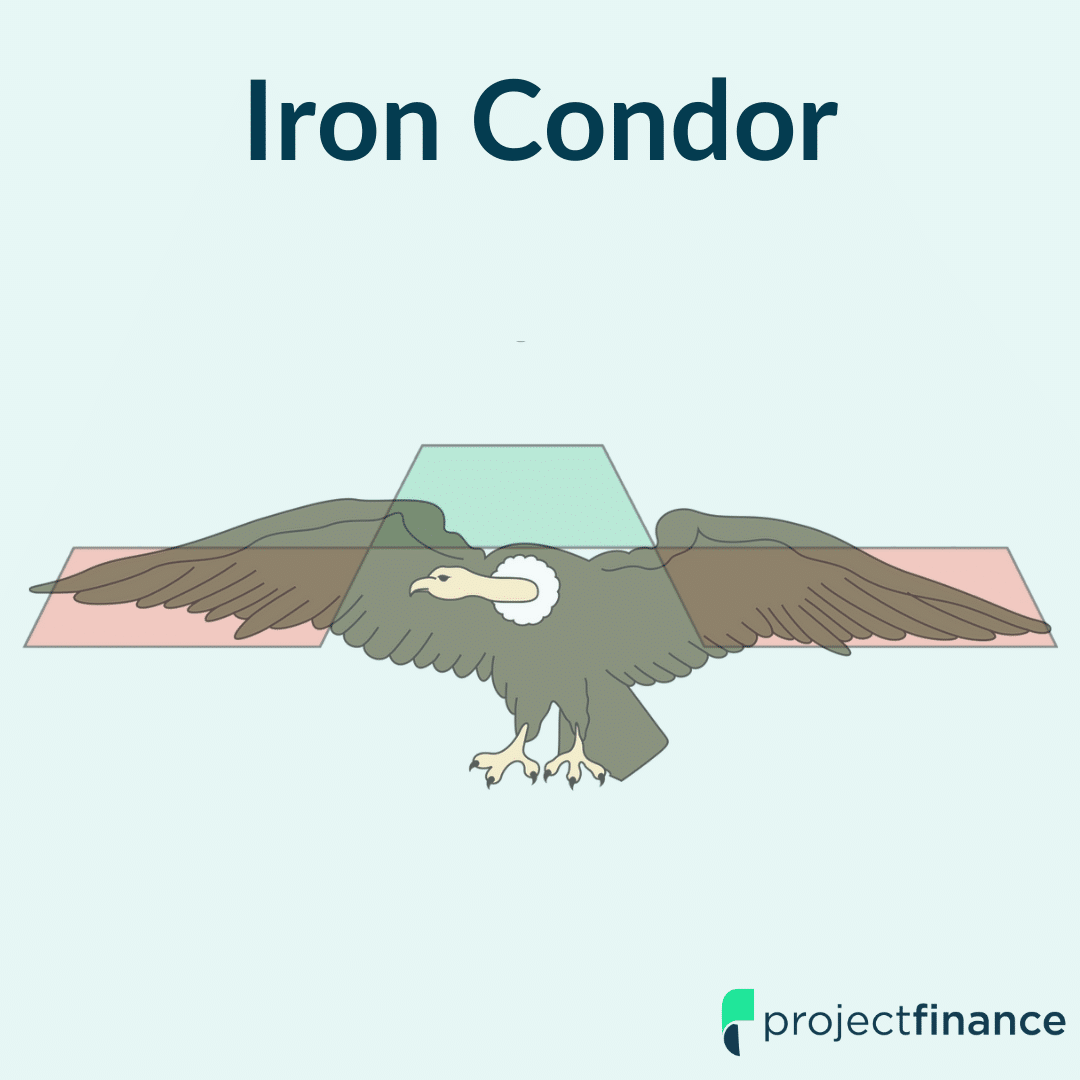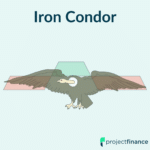Last updated on February 10th, 2022 , 07:32 pm
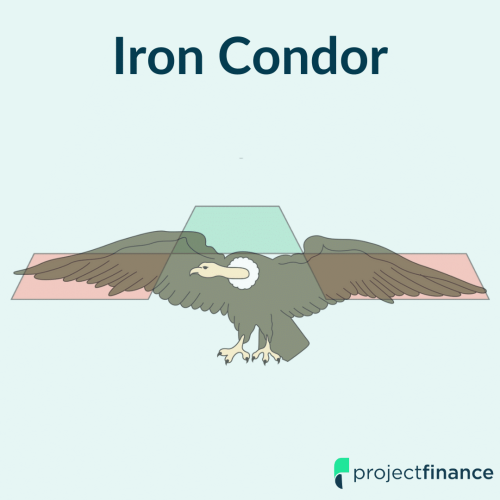
Sometimes, you’ll need to make an adjustment to your option positions when the stock price moves against you.
In this post, we’re going to discuss the iron condor adjustment strategy of rolling up the short put spreads.
Additionally, we’ll discuss the benefits of this iron condor adjustment strategy, as well as its drawbacks.
What is Rolling?
In options trading, “rolling” refers to closing an existing option position and opening a similar option position with different strike prices, in a different expiration cycle, or a combination of the two.
Today, we’ll focus on “rolling up” the short put spread in a short iron condor position, which refers to buying back your current short put spread and “rolling it up” by selling a new put spread at higher strike prices.
Rolling an Option
The process of closing an existing option and opening a similar option position at different strike prices, in a different expiration cycle, or a combination of the two.
When Do You Roll Up the Put Spread?
When trading iron condors, the most typical time to roll up the short put spread is after the stock price increases towards your short call spread.
Consider the following visual:
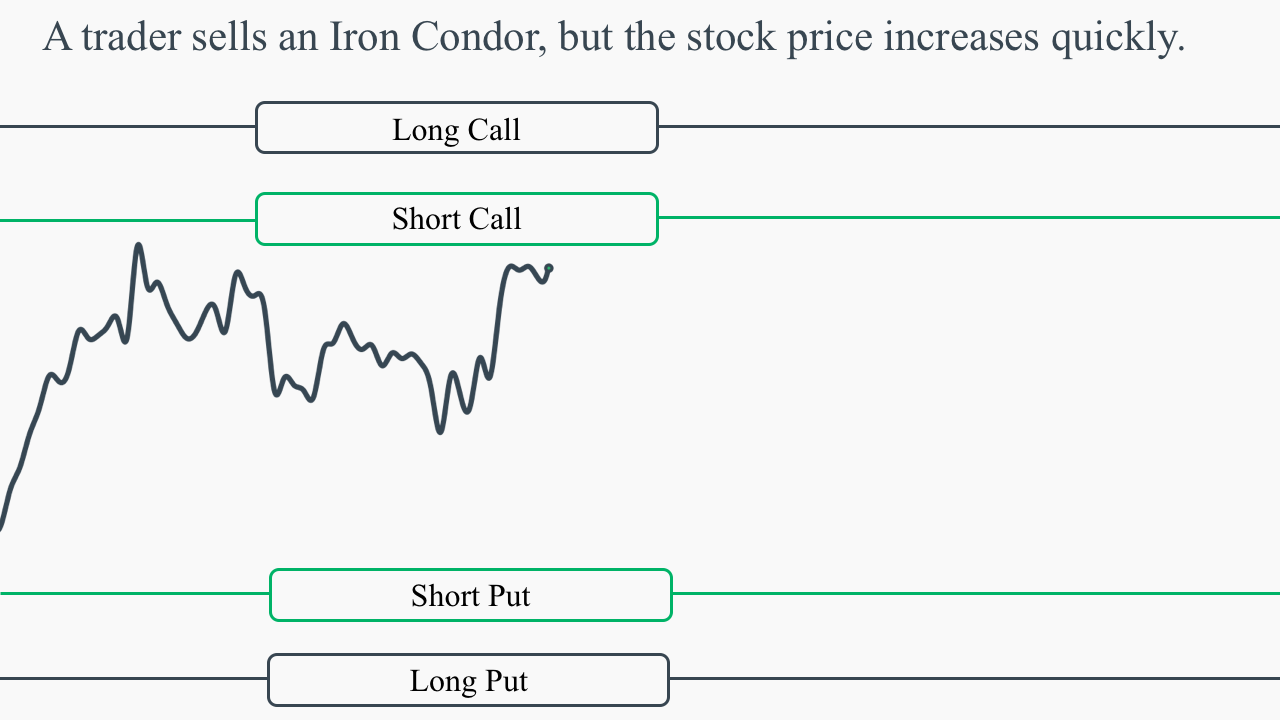
As we can see, the stock price is rising quickly and approaching the short call spread portion of the trade. Since short iron condors have negative gamma, the position’s delta grows negative (the position becomes bearish) as the stock price trends towards the short call.
The most common iron condor adjustment to make in this scenario is to roll up the short put spread to higher strike prices:
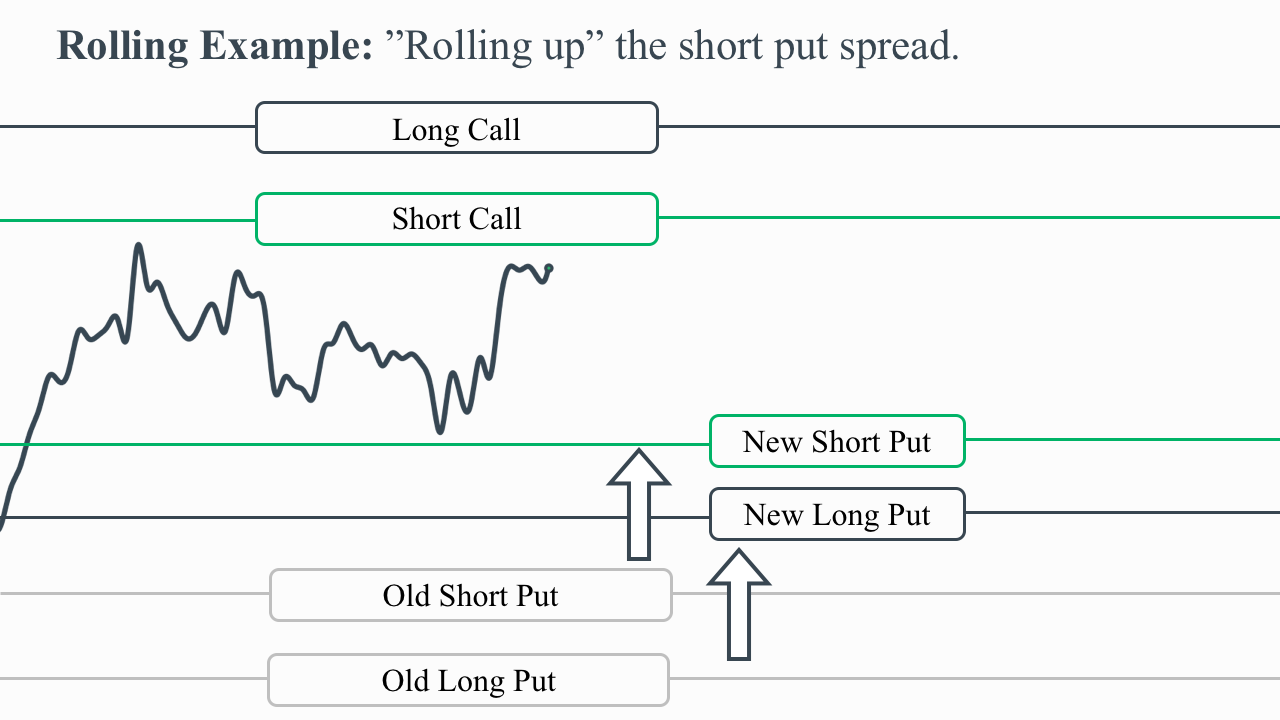
To roll up the short put spreads in an iron condor position, a trader has to buy back the old short put spread and sell a new put spread at higher strike prices.
What does this iron condor adjustment accomplish?
What Does Rolling Up the Put Spreads Accomplish?
By rolling up the short put spreads in an iron condor position, a trader accomplishes two things:
Rolling up the put spread is done for a net credit, as the new put spread is sold for more than the trader pays to buy back the old put spread. By collecting additional option premium, the maximum loss potential of the position is reduced and the maximum profit potential increases by the amount of the credit received from rolling.
However, the spreads are now closer together, which means the iron condor position has a narrower range of maximum profitability.
By rolling up the put spreads, the iron condor’s directional exposure will shift from bearish to more neutral.
Why?
At the time of rolling up the put spreads, an iron condor will have a negative position delta, which means the trader will lose money from subsequent increases in the stock price.
When the put spreads are rolled to higher strike prices, the new put spreads will have a more positive position delta than the old spreads, which brings the iron condor’s overall delta exposure closer to zero.
Let’s cover each of these points in more depth.
#1: Collect More Option Premium
Consider a trader who is short the 130/120 put spread in their iron condor position but decides to roll up to the 145/135 put spread:
How much option premium is collected by rolling up this put spread?
Premium Collected:
$2.37 Collected from 145/135 Put Spread
– $0.44 Paid for the 130/120 Put Spread
= +$1.93 ($193 Less Risk & $193 More Profit Potential)
By rolling up the short put spread, the overall premium received in this iron condor position increases by $1.93, which means the position has $1.93 less risk and $1.93 more profit potential.
However, since the new put spread is much closer to the stock price, the stock has less room to move, leading to a tighter range of maximum profitability.
#2: Neutralize Your Position Delta
After rolling up the short put spreads in an iron condor, the directional exposure becomes more neutral.
At the time of rolling, lets say the iron condor’s position delta was -25 (the trader is expected to lose $25 with a $1 increase in the stock price, and make $25 with a $1 decrease in the stock price). Here’s how the position delta would change after rolling up the put spread:
To calculate the new iron condor delta exposure, let’s compare the old put spread’s delta to the new put spread’s delta, and add the difference to the iron condor’s current position delta of -25:
Old Put Spread Delta: +6 (+9 Short Put Position Delta – 3 Long Put Position Delta)
New Put Spread Delta: +24 (+39 Short Put Position Delta – 15 Long Put Position Delta)
Change in Put Spread Deltas: +18
New Iron Condor Delta: -25 + 18 = -7
To clarify, the put spread deltas are calculated with the following formula:
(Short Put Delta x -1 Contract x 100 Option Multiplier) – (Long Put Delta x +1 Contract x 100 Option Multiplier)
After rolling up the put spread, the iron condor’s delta exposure changes from -25 to -7, which means the iron condor is now 72% less sensitive to small changes in the stock price.
More specifically, the trader is only expected to lose $7 with a $1 increase in the stock price as opposed to a $25 loss before the iron condor adjustment.
What’s the Risk of Rolling Up the Put Spreads?
While rolling up a short put spread decreases trade risk, increases maximum profit potential, and neutralizes the iron condor’s directional exposure, there are some downsides:
An iron condor’s maximum profit zone lies between the short call and short put strike price. After rolling up the put spreads, the short call and short put strike prices are now much closer, which results in a much narrower range of maximum profitability.
By neutralizing the iron condor’s directional exposure, a reversal in the stock price will yield less profits (or even losses) than before rolling up the put spreads.
As with any trade adjustment, there are benefits and downsides. The iron condor adjustment strategy of rolling up the short put spreads decreases the loss potential, increases the profit potential, but ultimately makes the trade a lower probability position since the maximum profit zone is now tighter.
Concept Checks
Here are the essential points to remember the iron condor adjustment of rolling up the short put spreads:
1. When trading iron condors, if the share price appreciates towards your short call spread, you can adjust the position by rolling up the put spreads to higher strike prices. | |
|---|---|
2. By rolling up the put spreads, you collect more option premium, which increases the profit potential and decreases the loss potential, but decreases the trade’s probability of profit since the profit zone is narrower. Additionally, the iron condor’s directional exposure becomes more neutral. | |
3. The downside of rolling up the put spreads are a decreased range of profitability, and a more neutral directional exposure. If the stock price ends up falling after the put spreads are rolled to higher strikes, the iron condor may end up losing money on the downside. |

